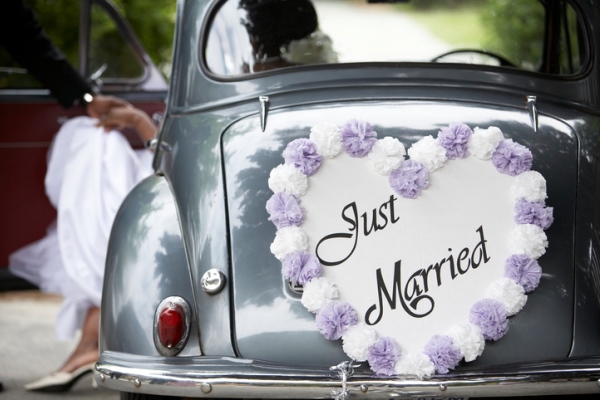Getting engaged is a giddy, exciting time. But planning the actual wedding isn’t always so blissful. That’s because keeping expenses in check is a huge concern for couples, says Sharon Naylor, author of 1,001 Ways to Save Money…and Still Have a Dazzling Wedding. She shares tips on how to steer clear of the five most common planning pitfalls. That way, you can throw the wedding of your dreams without breaking the bank.
Get Real With Your Budget
Many couples experience sticker shock as soon as they start planning for their wedding. Soon after getting engaged, discuss your priorities and determine what percentage of your monthly income can be put toward wedding festivities—then set that money aside into a wedding fund. “You should each make a list of five things that are most important to you,” Naylor says, and the cost of those key elements will provide a baseline for a realistic budget.
See If Family Will Chip In
“Sometimes in the blush of excitement, parents will say they want to give X amount, but then other unexpected expenses come up,” Naylor says. If parents don’t bring up contributing, you can broach the subject by saying, “We’re starting to build the budget for the wedding, and we’d like to know if there’s anything you want to help plan.” This phrasing helps open the dialogue without putting Mom and Dad in an awkward position.
Read The Fine Print
With each vendor contract, note details like whether any tips are already included (catering, waitstaff, hair and makeup, band, DJs and transportation all typically earn tips), or what time rentals need to be returned. Not knowing about these extras may leave you paying double in tips or incurring late charges. And don’t forget to line-item miscellaneous costs like gifts for the wedding party, event insurance, jewelry insurance and the marriage license.
Don’t Get Stuck On Your Inspiration Board
Mood boards are meant to serve as inspiration, not exact blueprints. Share photos of weddings that inspire you, but be open to vendors’ suggestions that can help your day be beautiful and affordable. Flowers tend to be the quickest cost to mushroom, followed by decor, Naylor says. Florists can suggest more affordable in-season blooms, and your caterer can help you do the same for the menu.
Keep The Guest List In Check
Set up guidelines with your partner to prevent your wedding size from spiraling out of control. If there’s family pressure to invite distant relatives, Naylor suggests saying: “We have to go by X number due to what the space allows.” When it comes to work colleagues, discuss who warrants an invite (say, if office diplomacy dictates that someone’s Big Boss is a must), then build that into your budget. For plus-ones, Naylor likes the rule of only inviting couples with whom you’ve socialized.
Once you’ve planned your dream wedding, check out our smart money tips for newlyweds.
By Sarah Bruning
5 Ways To Save Money On An Engagement Ring

Princess. Marquise. Round brilliant. Cushion.
It’s no mystery that diamonds come in a variety of shapes and sizes. The question is, which one is right for your budget?
True love doesn’t come with a price tag, of course, but a romantic proposal doesn’t necessarily have to break the bank. With young workers today earning 5.5 percent less (after adjusting for inflation) than they did four decades ago, according to U.S. Census data, the adage of spending two months’ salary on an engagement ring may not be an option for everyone. Couples are finding new ways to save money on rings, whether by careful stone selection or doing away with a diamond altogether.
“Millennials are making getting engaged all their own,” says Brooke Brinkman, VP of marketing and communications at Simon G. Jewelry, a luxury jewelry brand that specializes in engagement and wedding rings. “While traditional engagement rings still make an appearance, new trends are on the rise.”
Before popping the question, here’s an expert take on how you could save money on the ring of all rings.
1. Size Down & Shape Up
Round brilliant cut diamonds are the most popular stone for engagement rings, and even on a budget, they’re still an option. Diamonds, like other gemstones, are measured in carats, and their price generally rises with their size. So you could cut costs by purchasing a slightly smaller diamond—and in some cases, the difference will be imperceptible. “A 0.9-carat diamond will look very similar to a 1-carat once it’s in the setting,” says Mehul Sompura, CEO and founder of Diamond Hedge, a diamond price-comparison company. “To the naked eye, you can’t really tell the difference in size once set. But there’s a large jump in price when you get to the whole numbers.”
Another trick? Change the shape. Since round brilliant cut diamonds are the most sought after, they tend to be the costlier choice. A shape like princess or oval could help lower the cost and help keep the carat size in your ideal range. “Oval diamonds appear larger because they carry most of their weight on the surface and elongate the finger,” says Brinkman.
2. Take A Small Step Down In Color & Clarity
Carats measure weight, but diamonds have other scales too. Color is graded from D (colorless) to Z (faintly yellow). Clarity is noted by a range of abbreviations that include FL (“flawless”) and SI (“slightly included,” i.e., having internal markings not visible to the naked eye). The difference in both will again be difficult to see, and the savings could be substantial, says Brinkman.
“The best value can be found by choosing a stone that is G or H in color and SI in clarity,” she says. This will give you a stone that looks great “and helps you avoid paying for things your eye won’t be able to discern.”
3. Buy More Diamonds
It sounds counterintuitive, but a ring with multiple small stones can be a cheaper option than one with a single large gem. A popular choice right now is a mosaic setting, Sompura says, which consists of “tiny diamonds in an oval or heart shape, positioned so close together that it looks like that shape.” Another favored setting using multiple stones is the halo. By surrounding a center stone with smaller stones, the design gives the head of the ring a greater surface area and therefore a larger appearance.
4. Skip Diamonds Altogether
Diamonds haven’t always been popular: Before World War II, a vast majority of proposals didn’t involve diamond engagement rings. By the 1990s, however, it was hard to find a bride without one. Today, new trends like colored stones compete with the classic diamond ring more than ever before. Stones like sapphires, rubies and emeralds are just as beautiful and can be unique, says Sompura. He’s seen many couples choose an alternative center stone with diamonds set around it or on the band, or rings that have no diamonds at all.
5. Know Your Metals
Just like the stone itself, the metal you choose influences the cost of the ring. “The biggest price difference is between platinum and gold,” says Sompura. “Platinum is stronger and more durable than gold, so if you want stronger prongs, then you should go with platinum,” he says.
Beyond color and appearance, shoppers should consider the longevity, upkeep and level of scratch-resistance before settling on a metal. Of course, just as the classic 18-karat white gold will run up the price, a band made of titanium (which is usually a darker shade of silver) could result in some savings, says Sompura.
Love may be priceless, but no matter how much you save on an engagement ring, it’s still a once-in-a-lifetime purchase. Learn more about jewelry insurance through the GEICO Insurance Agency at geico.com.
Read More: Find out if your heirlooms are safe by taking this short, fun quiz.
Illustration by Luc Melanson











Roelavi Atelier says,
Thanks for sharing! Your blog always contains informative material